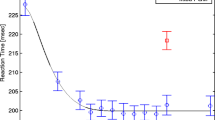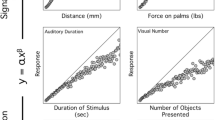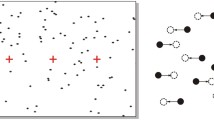Abstract
Simple reaction time is the minimum time required to respond to a signal such as a steady light or tone. Such a reaction time is taken to be the time required for transmission of a fixed quantity of information, ΔH, from stimulus to subject. That is, information summation replaces energy summation. This information is calculated from consideration of the quantum nature of the stimulus. The theoretically derived equation for reaction time is fitted to experimental data. Piéron's empirical law for reaction time is obtained as an approximation from a proposed informational equation. The exponent in Piéron's law is found to be the same as the exponent in the power law of sensation. Threshold appears to be the smallest stimulus capable of transmitting the quantity of information ΔH.
Similar content being viewed by others
Literature
Boynton, R. M. 1961. “Some Temporal Factors in Vision.”Sensory Communication, W. A. Rosenblith (Ed.), pp. 739–756. New York: M.I.T. Press/Wiley.
Cattell, J. M. 1886. “The Influence of the Intensity of the Stimulus on the Length of the Reaction Time.”Brain 8, 512–515.
Chocholle, R. 1940. “Variations des Temps de Réaction Auditifs en Fonction de l'Intensité à Diverses Fréquences.”Année Psychol. 41, 65–124.
Coren, S., C. Porac and L. Ward. 1984.Sensation and Perception (2nd Edn). Orlando, FL: Academic Press.
Doma, H. and P. E. Hallett. 1988. “Rod-Cone Dependence of Saccadic Eye-Movement Latency in a Foveating Task.”Vision. Res. 28, 899–913.
Hellyer, S. 1963. “Stimulus-Response Coding and Amount of Information as Determinants of Reaction Time.”J. Exp. Psychol. 65, 521–522.
Hick, W. E. 1952. “On the Rate of Gain of Information.”Q. J. Exp. Psychol. 4, 11–26.
Hyman, R. 1953. “Stimulus Information as a Determinant of Reaction Time.”J. Exp. Psychol. 45, 188–196.
Kohfeld, D. L. 1969. “Effects of Ready-Signal Intensity and Intensity of Preceding Response Signal on Simple Reaction Time.”Am. J. Psychol. 82, 104–110.
Libet, B. 1985. “Unconscious Cerebral Initiative and the Role of Conscious Will in Voluntary Action.”Behav. Brain Sci. 8, 529–566.
Luce, R. D. 1986.Response Times and their Role in Inferring Elementary Mental Organization. New York: Oxford University Press.
Mansfield, R. J. W. 1973. “Latency Functions in Human Vision.”Vision Res. 13, 2219–2234.
Marks, L. 1974. “On Scale of Sensation.”Percept. Psychophys. 16, 358–376.
Norwich, K. H. 1977. “On the Information Received by Sensory Receptors.”Bull. math. Biol. 39, 453–461.
—. 1981a “Uncertainty in Physiology and Physics.”Bull. math. Biol. 43, 141–149.
—. 1981b. “The Magical Number Seven: Making a ‘Bit’ of ‘Sense’.”Percept. Psychophys. 29, 409–422.
—. 1983. “To Perceive is to Doubt: The Relativity of Perception.”J. theor. Biol. 102, 175–190.
—. 1984. “The Psychophysics of Taste from the Entropy of the Stimulus.”Percept. Psychophys. 35, 269–278.
—. 1987. “On the Theory of Weber Fractions.”Percept. Psychophys. 42, 286–298.
Piéron, H. 1952. The Sensations. New Haven Yale University Press.
Ueno, T. 1976. “Luminance-Duration Relation in Reaction Time to Spectral Stimuli.”Vision Res. 16, 721–725.
Vaughan, H. G., Jr., L. D. Costa and L. Gilden. 1966. “The Functional Relation of Visual Evoked Response and Reaction Time to Stimulus Intensity.”Vision Res. 6, 645–656.
Ward, L. M. and K. Davidson. 1988. “‘n’ tropy is Everywhere.” 29th annual meeting of the Psychonomic Society Abstr. No. 225.
Welford, A. T. 1980. “Choice Reaction Time: Basic Concepts.”Reaction Times, A. T. Welford (Ed.). London: Academic Press.
Williams, D. H. and T. M. Allen. 1971. “Absolute Thresholds as a Function of Pulse Length and Null Period.”The Perception and Application of Flashing Lights, pp. 43–54. University of Toronto Press.
Author information
Authors and Affiliations
Rights and permissions
About this article
Cite this article
Norwich, K.H., Seburn, C.N.L. & Axelrad, E. An informational approach to reaction times. Bltn Mathcal Biology 51, 347–358 (1989). https://doi.org/10.1007/BF02460113
Received:
Revised:
Issue Date:
DOI: https://doi.org/10.1007/BF02460113




